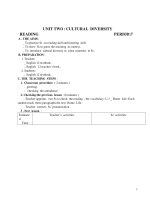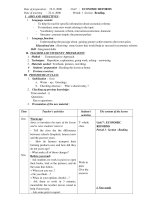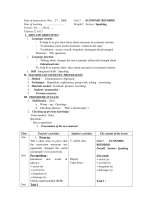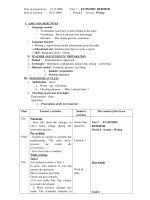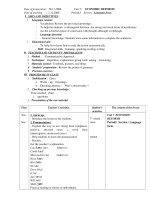LESSON PLAN ISWGR6T7
Bạn đang xem bản rút gọn của tài liệu. Xem và tải ngay bản đầy đủ của tài liệu tại đây (89.23 KB, 14 trang )
Grade 6 – Theme 7: Robots
Period 61-62
Lesson 1 - Objectives: by the end of this lesson, students can:
- talk about the kinds of work robots can do in different environments.
- use “can” and “can’t” to talk about abilities.
Topic – Language target
Resources and Teaching Aids
Key Activities
Vocabulary:
Resources:
Aims
kinds of work robots can do in
STUDENT’s BOOK p.64-65
1. Have students look at the lesson aims as you read them aloud.
different environments
2. Have students look at the examples from the Useful Language box.
3. Explain that by the end of the lesson, they'll be able to use the same language
New words
a. Match the words with the phrases. Check with a partner. Listen and repeat. (CD2-19)
Grammar:
Teaching Aids:
1. Demonstrate the activity using the example.
use “can” and “can’t” to talk
CD2 track 19,20,21,22
2. Have students match the words with the phrases.
about abilities
3. Divide the class into pairs and have them check their answers with their partners.
4. Play audio. Have students listen and repeat.
b. With your partner, add three more places robots can work to the list above. Share with the
class.
1. Have pairs write three places they think robots can work.
2. Elicit their answers and write them on the board.
Listening
Listen and complete (CD2 – 20)
a. Two friends s are talking to an expert about robots.
Listen and circle “True” or “False”. (CD2-20)
1. Play audio and demonstrate the activity using the example.
2. Play audio and have students listen and circle “True” or “False”.
3. Play audio again and check answers as a whole class.
b. Fill in the blanks. Listen again and check
1. Demonstrate the activity using the example.
2. Have students fill in the blanks.
3. Play audio again. Have students listen and check.
Useful language
Listen then practice (CD2 - 21)
1. Have students look at the Useful Language box.
2. Play audio. Have students listen to the useful language.
3. Have students practice the useful language.
Grammar
Unscramble the sentences
1. Demonstrate the activity using the example.
2. Have students unscramble the sentences.
3. Have students check their answers with a partner.
4. Check answer as a whole class.
5. Have pairs practice asking and answering.
6. Have some students demonstrate the activity in front of the class.
Pronunciation
a. Isolate
Focus on the example and briefly explain the focus.
b. Model (CD2-22)
1. Have students listen and notice the pronunciation feature
2. Play audio once and draw attention to the pronunciation feature
c. Practice
Play audio again. Have students listen and repeat with a focus on the feature.
Practice
Practice the conversation
1. Have students look at the conversation.
2. Divide the class into pairs and have them practice the conversation.
3. Swap roles and repeat.
4. Have some pairs demonstrate the activity in front of the class.
Speaking
What Can Your Robot Do?
a. You’re designing a robot for a competition. Work in pairs. Design your robot and talk about
what kind of work it can do.
b. Share with the class.
1. Divide the class into pairs.
2. Have pairs complete the form, discussing where their robot can work and all things it can do.
3. Have students draw the robots and give it a name.
4. Have some pairs share with the class.
Grade 6 – Theme 7: Robots
Period 61-62
Lesson 1 - Objectives: - talk about the kinds of work robots can do in different environments
- use “can” and “can’t” to talk about abilities
Topic – Language target
Resources and Teaching Aids
Key Activities
Vocabulary:
Resources:
New Words
kinds of work robots can do in
WORKBOOK p.62-63
a. Look at the pictures. Fill in the missing letters.
different environments
1. Have students look at the pictures.
2. Demonstrate the activity using the example.
3. Have students fill in the missing letters.
4. Divide the class into pairs and have students check answers with their partners.
Grammar:
5. Check answers as a whole class.
use “can” and “can’t” to talk
b. Fill in the blanks using the words in the box.
about abilities
1. Draw students’ attention to the blanks in sentences.
2. Have students look at the words in the box.
3. Demonstrate the activity using the example.
4. Have students fill in the blanks using the words in the box.
5. Have students check their answers with partners.
6. Check answers as a whole class.
Grammar
a. Read the conversation and choose the best answer. Write a letter (A-F) for each answer.
1. Have students look at the conversation.
2. Draw students’ attention to information A-F in the box.
3. Demonstrate the activity using the example.
4. Have students read the conversation and choose the best answer.
5. Have students check their answers with a partner.
6. Check answers as a whole class.
b. Unscramble the sentences.
1. Demonstrate the activity using the example.
2. Have students unscramble the sentences.
3. Check answers as a whole class.
c. Look at the pictures. Write the answers.
1. Have students look at the pictures.
2. Draw students’ attention to questions.
3. Have students answer the questions.
4. Have students check their answers with partners.
5. Check answers as a whole class.
Write
Write about your dream robot by answering the questions in Grammar Exercise b.
1. Have students look at the questions in Grammar Exercise b.
2. Have students write the answers for the questions in Grammar Exercise b.
3. Have students write about their dream robots by answering the questions in Grammar
Exercise b.
4. Have some students demonstrate their writing in front of the class.
Grade 6 – Theme 7: Robots
Lesson 2 - Objectives: by the end of this lesson, students can:
- express agreement and disagreement about the roles of robots in our lives
- use “because” to give reasons
Topic – Language target
Resources and Teaching Aids
Period 63-64
Key Activities
Vocabulary:
express agreement and
disagreement about the roles
of robots in our lives
Resources:
STUDENT’s BOOK p.66-67
Grammar:
use “because” to give reasons
Teaching Aids:
CD2-Track 23, 24, 25, 26
Aims
1. Have students look at the lesson aims as you read them aloud.
2. Have students look at the examples from the Useful Language box.
3. Explain that by the end of the lesson, they'll be able to use the same language.
New words
a. Number the pictures. Check with a partner. Listen and repeat. (CD2-23)
1. Demonstrate the activity using the example.
2. Have students read the words.
3. Have students number the pictures.
4. Divide the class into pairs and have them check their answers with their partners.
5. Play audio. Have students listen and repeat.
b. With your partner, add one more word to the blanks above. Share with the class.
1. Have pairs add one more word for each list.
2. Elicit their answers and write them on the board.
Listening
a. Toby and Lisa are talking about robots. Listen and write “agrees” or “disagrees”. (CD2 – 24)
1. Play audio and demonstrate the activity using the example.
2. Play audio and have students listen and write “agrees” or “disagrees”
3. Play audio again and check answers as a whole class.
b. Circle the correct words. Listen again and check.
1. Demonstrate the activity using the example.
2. Have students read the sentences and circle the correct words.
3. Play audio again. Have students listen and check.
Useful language
Listen then practice (CD2-25)
1. Have students look at the Useful Language box.
2. Play audio. Have students listen to the useful language.
3. Have students practice the useful language.
Grammar
Fill in the blanks
1. Demonstrate the activity using the example.
2. Have students fill in the blanks with the words in the box.
3. Have students check their answers with a partner.
4. Check answers as a whole class.
5. Have students practice saying the sentences.
6. Have some students read their answers in front of the class.
Pronunciation
a. Isolate
Focus on the example and briefly explain the focus.
b. Model (CD2-26)
1. Have students listen and notice the pronunciation feature.
2. Play audio once and draw attention to the pronunciation feature.
c. Practice
Play audio again. Have students listen and repeat with a focus on the feature.
Practice
Say the statements and say if you agree or disagree
1. Demonstrate the activity.
2. Divide the class into pairs.
3. Have pairs take turns saying the statements and agreeing or disagreeing with three reasons
why.
Speaking
The Role of Robots in Our Lives
a. You’re discussing two different roles of robots. Work in fours. Pair 1, think of three reasons
to use robot soldiers. Pair 2, think of three reasons to use rescue robots. Find three reasons
to disagree with the other pair.
1. Divide the class into groups of fours and have these groups make two pairs.
2. Have Pair 1 think of three reasons to use robot soldiers.
3. Have Pair 2 think of three reasons to use rescue robots.
4. Have pairs find three reasons to disagree with the other pair.
b. In four, discuss your reasons and vote for each robot. Share your results with the class.
1. Have pairs join together and discuss their reasons.
2. Have groups vote to agree or disagree and write down the number of votes in each box.
3. Have some groups share their findings with the class.
Grade 6 – Theme 7: Robots
Lesson 2 - Objectives: - express agreement and disagreement about the roles of robots in our lives
- use “because” to give reasons
Topic – Language target
Vocabulary:
express agreement and
disagreement about the roles
of robots in our lives
Resources and Teaching Aids
Resources:
WORKBOOK p.64-65
Period 63-64
Key Activities
New Words
a. Unscramble the words and phrases. Then take the letters that appear in
boxes and
unscramble them for the final message.
1. Demonstrate the activity using the example.
2. Have students unscramble the words and phrases.
3. Have students take the letters that appear in
boxes and unscramble them for the final
Grammar:
use “because” to give reasons
message.
4. Have students check their answers with partners.
5. Check answers as a whole class.
b. Read the sentences and circle the correct answers.
1. Have students look at the sentences.
2. Draw students’ attention to the blank in each sentence.
3. Have students look at three choices in each sentence.
4. Demonstrate the activity using the example.
5. Have students read the sentences and circle the correct answers.
6. Have students check their answers with partners.
7. Check answers as a whole class.
Grammar
a. Match the questions with the answers.
1. Have students look at the questions.
2. Draw students’ attention to the answers.
3. Demonstrate the activity using the example.
4. Have students match the questions with the answers.
5. Have students check their answers with partners.
6. Check answers as a whole class.
Write
Write the answers using “because” and your own ideas.
1. Have students look at the questions.
2. Demonstrate the activity.
3. Have students write the answers using “because” and their own ideas.
4. Divide the class into pairs and have students check their answers with their partners.
5. Have some students demonstrate their writing in front of the class.
Grade 6 – Theme 7: Robots
Period 65-66
Lesson 3 - Objectives: by the end of this lesson, students can:
- compare and choose the best robots for different tasks
- use superlative forms of adjectives
Topic – Language target
Resources and Teaching Aids
Key Activities
Vocabulary:
Resources:
Aims
compare and choose the best
STUDENT’s BOOK p.68-69
1. Have students look at the lesson aims as you read them aloud.
robots for different tasks
2. Have students look at the examples from the Useful Language box.
3. Explain that by the end of the lesson, they'll be able to use the same language.
Grammar:
Teaching Aids:
New words
use superlative forms of
CD2 - Track 27, 28, 29, 30
a. Write the words under the pictures. Check with a partner. Listen and repeat. (CD2-27)
adjectives
1. Have students look at the pictures and words.
2. Demonstrate the activity using the example.
3. Have students write the words under the pictures.
4. Divide the class into pairs and have students check their answers with their partners.
5. Play audio. Have students listen and check.
b. With your partner, use the words above to describe someone or something. Share with the
class.
1. Have pairs use the new words to describe someone or something.
2. Have some pairs share with the class.
Listening
a. Two friends are discussing robots at a robot fair. Listen and circle “True” or “False”.
(CD2 -28)
1. Play audio and demonstrate the activity using the example.
2. Play audio. Have students listen and circle “True” or “False”.
3. Play audio again and check answers as a whole class.
b. Fill in the blanks with the correct form of the adjectives. Listen again and check.
1. Demonstrate the activity using the example.
2. Have students read the sentences and fill in the blanks.
3. Play audio again. Have students listen and check.
Useful language
Listen then practice (CD2-29)
1. Have students look at the Useful Language box.
2. Play audio. Have students listen to the useful language.
3. Have students practice the useful language.
Grammar
Write the superlative form of the adjectives. Check with a partner. Practice the conversation.
1. Demonstrate the activity using the example.
2. Have students read the sentences and fill in the blanks with the superlative form of the
adjectives.
3. Have students check their answers with a partner.
4. Check answers as the whole class.
5. Have students practice the conversation.
6. Have some students demonstrate the activity in front of the class.
Pronunciation
a. Isolate
Focus on the example and briefly explain the focus.
b. Model (CD2- 30)
1. Have students listen and notice the pronunciation feature.
2. Play audio once and draw attention to the pronunciation feature.
c. Practice
Play audio again. Have students listen and repeat with a focus on the feature.
Practice
Compare the robots using the information.
1. Demonstrate the activity.
2. Divide the class into pairs.
3. Have students take turns comparing the robots using the information.
4. Have some students demonstrate the activity in front of the class.
Speaking
The Best Robot for the Job
a. You’re discussing which robots would be best for different jobs. Work in pairs. Discuss and
write two adjectives from New Words which would be useful for the jobs below.
1. Demonstrate the activity.
2. Divide the class into pairs.
3. Have students write two adjectives from New Words that are important for each job.
4. Have students turn to page 112, File 18.
5. Have students discuss the robots and choose one for each job.
6. Have pairs work with another pair and share their results.
7. Have some students share their results with the class.
Grade 6 – Theme 7: Robots
Lesson 3 - Objectives: - compare and choose the best robots for different tasks
- use superlative forms of adjectives
Topic – Language target
Resources and Teaching Aids
Key Activities
Vocabulary:
Resources:
New Words
compare and choose the best
WORKBOOK p.66-67
a. Match the words to the correct descriptions.
robots for different tasks
1. Have students look at the words and the descriptions.
2. Demonstrate the activity using the example.
Grammar:
3. Have students match the words to the correct descriptions.
use superlative forms of
4. Check answers as a whole class.
adjectives
b. Fill in the blanks using the words in the box.
1. Draw students’ attention to the blanks in sentences.
2. Have students look at the words in the box.
3. Demonstrate the activity using the example.
4. Have students fill in the blanks using the words in the box.
5. Have students check their answers with partners.
6. Check answers as a whole class.
Grammar
a. Complete the tables.
1. Demonstrate the activity using the example.
2. Have students supply the correct form.
3. Divide the class into pairs and have them check their answers with partners.
4. Check answers as a whole class.
Period 65-66
b. Circle the correct words.
1. Have students look at the sentences.
2. Demonstrate the activity using the example.
3. Have students circle the correct words.
4. Check answers as a whole class.
c. Put a tick (✓) for a correct sentence and a cross (✗) for an incorrect one. Then write the
correct words on the lines.
1. Have students look at the sentences.
2. Demonstrate the activity using the example.
3. Have students put a tick (✓) for a correct sentence and a cross (✗) for an incorrect one and
write the correct words on the lines.
4. Have students check their answers with partners.
5. Check answers as a whole class.
Write
Write five sentences to compare three robots. Which robot would make the best soccer
player?
1. Have students look at the information about three robots.
2. Demonstrate the activity.
3. Have students write five sentences to compare three robots.
4. Have students write which robot would make the best soccer player.
5. Have some students demonstrate their writing in front of the class.
Grade 6 – Theme 7: Robots
Period 67-68
Lesson 4 - Objectives: by the end of this lesson, students can:
- talk about life on a space station.
- use the Present Simple tense for repeated actions.
Topic – Language target
Resources and Teaching Aids
Key Activities
Vocabulary:
Resources:
Aims
life on a space station
STUDENT’s BOOK p.70-71
1. Have students look at the lesson aims as you read them aloud.
2. Have students look at the examples from the Useful Language box.
3. Explain that by the end of the lesson, they'll be able to use the same language.
Grammar:
Teaching Aids:
New words
the Present Simple tense for
CD2 - Track 31, 32, 33, 34
a. Match the words with the phrases. Check with a partner. Listen and repeat. (CD2-31)
repeated actions
1. Demonstrate the activity using the example.
2. Have students match the words with the phrases.
3. Divide the class into pairs and have them check their answers with their partners.
4. Play audio. Have students listen and repeat.
b. With your partner, discuss whether you would like to visit a space station. Share with the
class.
1. Have pairs discuss whether they would like to visit a space station.
2. Have some pairs share their ideas with the class.
Listening
a. An astronaut is talking about life on a space station. Listen and number the pictures.
(CD2 -32)
1. Play audio and demonstrate the activity using the example.
2. Play audio. Have students listen and number the pictures.
3. Play audio again and check answers as a whole class.
b. Circle the correct words. Listen again and check. (CD2 -33)
1. Demonstrate the activity using the example.
2. Have students circle the correct words.
3. Play audio again. Have students listen and check.
Useful language
Listen then practice (CD2-34)
1. Have students look at the Useful Language box.
2. Play audio. Have students listen to the useful language.
3. Have students practice the useful language.
Reading
a. Read the text and fill in the blanks. Check with a partner.
1. Have students read the text individually.
2. Read the text as a whole class.
3. Demonstrate the activity using the example.
4. Have students fill in the blanks.
5. Check answers as a whole class.
b. Read the text again and answer the questions.
1. Have students read the text again.
2. Demonstrate the activity using the example.
3. Have students answer the questions.
4. Check answers as a whole class.
Speaking
Life on a Space Station
a. You’re talking to an astronaut at a science convention. Work in pairs. Student A, you’re a
reporter, choose four questions to ask your partner. Student B, you’re an astronaut, describe
life on a space station to your partner.
1. Demonstrate the role-play by asking and answering with one student.
2. Divide the class into pairs.
3. Have Student A be a reporter and have Student B be an astronaut.
4. Have Student A choose four questions to ask student B, then do the interview.
b. Would you like to live on a space station? Share with the class.
1. Swap roles and repeat. Have some students demonstrate in front of the class.
2. Have pairs talk about if they’d like to live in space.
3. Have some students share with the class.
Writing
Write a short paragraph describing life on a space station.
1. Have students look at Reading and Speaking as examples.
2. Have students write a paragraph about life on a space station.
3. Have some students read their writing in front of the class.
Grade 6 – Theme 7: Robots
Lesson 4 - Objectives: - talk about life on a space station.
- use the Present Simple tense for repeated actions.
Topic – Language target
Resources and Teaching Aids
Key Activities
Vocabulary:
Resources:
New Words
life on a space station
WORKBOOK p.68-69
a. Look at the pictures. Fill in the blanks and do the crossword puzzle.
1. Have students look at the pictures and the crossword puzzle.
2. Draw students’ attention to the clues.
Grammar:
3. Demonstrate the activity using the example.
the Present Simple tense for
4. Have students fill in the blanks and do the crossword puzzle.
repeated actions
5. Have students check their answers with partners.
6. Check answers as a whole class.
Read
a. Read the article and choose the correct answer.
1. Have students read the text.
2. Have students choose the correct answer.
3. Check answers as a whole class.
b. Read the article again and write the answers.
1. Have students read the article again.
2. Draw students’ attention to the questions.
3. Demonstrate the activity using the example.
4. Have students read the article and write the answers.
Period 67-68
5. Have students check their answers with partners.
6. Check answers as a whole class.
Write
Imagine you are an astronaut. Write a paragraph about your life in space.
1. Have students imagine they are astronauts.
2. Demonstrate the activity.
3. Have students write a paragraph about their life in space.
4. Have some students demonstrate the activity in front of the class.
Grade 6 – Theme 7: Robots
Period 69-70
Lesson 5 - Objectives: Review and Test practice
Topic – Language target
Vocabulary:
Review all vocabulary
- kinds of work robots can do in
different environments
- roles of robots in our lives
- life on a space station
Resources and Teaching Aids
Resources:
STUDENT’s BOOK p.72-73
Structure:
Review all structures
Teaching Aids:
CD2 - Track 35
Key Activities
Listening
Listen to Jack talking to his dad about a robot competition. What can each robot do? For
questions 1- 5, write a letter (A-H) next to each robot. You will hear the conversation twice.
(CD2 – 35)
1. Play audio and demonstrate the activity using the example.
2. Play audio. Have students listen and write a letter (A-H) next to each robot.
3. Play audio again and check answers as a whole class.
Reading
Complete this article. Write ONE word for each space. For questions 1-5, write the words.
1. Demonstrate the activity using the example.
2. Have students read and complete the article by writing one word for each space.
3. Check answers as a whole class.
Speaking
Play the “Connect Three” game
1. Demonstrate playing the game.
2. Divide the class into groups of four. Each group has two teams with two students in each
team.
3. Have teams play rock, paper, scissors. The winning team goes first.
4. Have the winning team point to a space on the board where they wish to put a mark. Then
ask and answer using the prompts.
5. If correct, that team can put a mark on the space (an X or O). If incorrect, the next team takes
their turn.
6. Swap roles and repeat until the game is finished.
7. The winners are the team that gets three of their own marks in a row, horizontally, vertically
or diagonally.
Writing
You want to design a new robot. Write a note to your friend about your robot. Write 25-35
words.
1. Have students look at the information.
2. Have students write a 25 to 35-word note about their robot.
3. Have some students read their writing in front of the class.
Grade 6 – Theme 7: Robots
Period 69-70
Lesson 5 - Objectives: Review
Topic – Language target
Vocabulary:
Review all vocabulary
Structures:
Review all structures
Resources and Teaching Aids
Resources:
WORKBOOK p.70-71
Key Activities
Part 1
Read and mark
Read the sentences about robots. Choose the best word (A, B or C) for each space.
Make A, B or C.
1. Have students read the sentences.
2. Draw students’ attention to the blank and three choices A, B and C in each sentence.
3. Demonstrate the activity using the example.
4. Have students read and mark A, B or C.
5. Check answers as a whole class.
Part 2
Read and mark
Complete the conversation between two friends. What does Jack answer to Kim? Mark the
correct letter A-F.
1. Demonstrate the activity using the example.
2. Have students read and complete the conversation by marking A-H.
3. Check answers as a whole class.
Part 3
Read and mark
Read the article Robots: Good or Bad. Are these sentences 1-10 ‘Right’ (A) or ‘Wrong’ (B)? If
there is not enough information to answer ‘Right’ (A) or ‘Wrong’ (B), choose ‘Doesn’t say’ (C).
Mark A, B or C.
1. Demonstrate the activity using the example.
2. Have students read the sentences and answer ‘Right’ (A), ‘Wrong’ (B) or ‘Doesn’t say’ (C).
3. Have students shade A, B or C in the answer column.
4. Divide the class into pairs and have students check their answers.
5. Check answers as a whole class.
